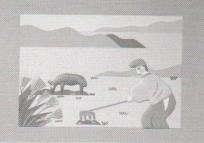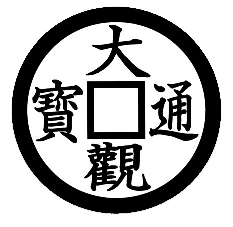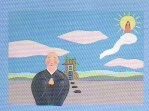|
|
All around, for as far as the eye could see, stretched vast plains of tall grass. Gradually, Kuro brought under cultivation the land on which he lived in a place called Nakano and soon began to breed horses. But times were difficult and his life was hard. On many days he had little of nothing to eat.
 One day he set off in the direction of Chiba, taking one thin horse with him to market. On the way he stopped to visit the famous temple of Kannon in Asakusa and made the following vow: “Please, Lord Kannon, let me sell this horse for a good price. If I am able to sell the horse and any special coins are included in the payment I receive, I will donate those coins to you.”
One day he set off in the direction of Chiba, taking one thin horse with him to market. On the way he stopped to visit the famous temple of Kannon in Asakusa and made the following vow: “Please, Lord Kannon, let me sell this horse for a good price. If I am able to sell the horse and any special coins are included in the payment I receive, I will donate those coins to you.”

He then went on his way to the market, where to his surprise he sold the horse for far more than he expected to receive. “This was certainly due to Lord Kannon,” he thought, and he was overjoyed. However, when he looked over the money he had been paid, he discovered that all the coins were of the special type. “What am I going to do?” He wondered. “I promised Lord Kannon I would offer all such coins to him. But if I do that, I will not have anything left for myself!” Puzzling over what course of action to take, he reached a decision. “I must keep my promise,” he told himself. “I was wrong to ask that the horse would bring a high price. Lord Kannon has taught me that money must come from hard work.”
Starting from the next day, Kuro set out to work harder than he had ever worked in all his life. Little by little, he amassed surprising wealth and had many people working for him. He was soon popularly known as Nakano Choja (the Rich Man of Nakano).
Without warning, however, bad luck struck him. His only daughter, Kozasa, fell ill and died. Kuro and his wife were grief-stricken. They offered prayers at many different temples and shrines and visited wise people near and far, but nothing comforted them.
 In 1438, Kuro visited a temple called Saijo-ji in Odawara and at the urging of its Zen master, Shuoku Sono, he built a hall on land at Juniso (West Shinjuku) and invited the priest and his retinue there to conduct a memorial service for Kozasa and to spread the teachings of Soto Zen Buddhism. That was the beginning of Jougan-ji.
In 1438, Kuro visited a temple called Saijo-ji in Odawara and at the urging of its Zen master, Shuoku Sono, he built a hall on land at Juniso (West Shinjuku) and invited the priest and his retinue there to conduct a memorial service for Kozasa and to spread the teachings of Soto Zen Buddhism. That was the beginning of Jougan-ji.
One day, Zen master Shuoku said, “Last year’s plum tree and this year’s willow show no change in their face or perfume.” Each of us manifests the source and the original face of all things through our individual physical form. That original face is none other than the Buddha. By leading our lives so that we value each moment and each encounter, and by honoring all things that exist, we can live calmly within the span of eternity. That was the underlying spirit of tranquility as understood by Zen master Shuoku and
|
|
|

